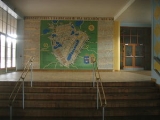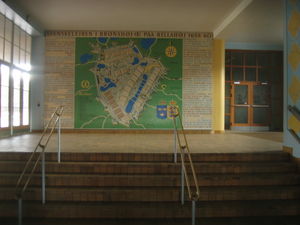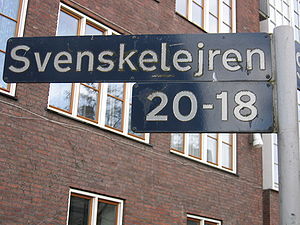
Carlstad
Encyclopedia


Denmark
Denmark is a Scandinavian country in Northern Europe. The countries of Denmark and Greenland, as well as the Faroe Islands, constitute the Kingdom of Denmark . It is the southernmost of the Nordic countries, southwest of Sweden and south of Norway, and bordered to the south by Germany. Denmark...
built by the forces of King Charles X Gustav
Charles X Gustav of Sweden
Charles X Gustav also Carl Gustav, was King of Sweden from 1654 until his death. He was the son of John Casimir, Count Palatine of Zweibrücken-Kleeburg and Catherine of Sweden. After his father's death he also succeeded him as Pfalzgraf. He was married to Hedwig Eleonora of Holstein-Gottorp, who...
of Sweden
Sweden
Sweden , officially the Kingdom of Sweden , is a Nordic country on the Scandinavian Peninsula in Northern Europe. Sweden borders with Norway and Finland and is connected to Denmark by a bridge-tunnel across the Öresund....
during his siege of the Danish capital, Copenhagen
Copenhagen
Copenhagen is the capital and largest city of Denmark, with an urban population of 1,199,224 and a metropolitan population of 1,930,260 . With the completion of the transnational Øresund Bridge in 2000, Copenhagen has become the centre of the increasingly integrating Øresund Region...
, 1658 - 1660 AD. Carlstad's size rivalled the besieged Danish capital, reaching a peak of approx. 30,000 inhabitants. The modern Copenhagen district of Brønshøj
Brønshøj
Brønshøj, part of the municipality of Copenhagen, forms, together with Husum, the administrative city district of Brønshøj-Husum. Brønshøj lies on rising ground 4 km west of Copenhagen center and is bordered by the large wetland area of Utterslev Mose to the north. A number of ponds, lakes,...
, Bellahøj
Bellahøj
Bellahøj Husene is a large housing project, 5km northwest of central Copenhagen, Denmark. It contains 28 high-rise blocks. Each block has between 9 and 13 floors. The housing project was among the first ever built in Scandinavia. It was the first with high-rise apartments in Copenhagen when it was...
and Utterslev are located on or near the site. Several nearby streets are named for it; e.g. Svenskelejren (The Swedish Camp) and Skansebjerg (Trench Hill). The only preserved building extant at the time of the encampment is Brønshøj Church, used as a weapons store during the siege.
History
After a successful campaign of JutlandJutland
Jutland , historically also called Cimbria, is the name of the peninsula that juts out in Northern Europe toward the rest of Scandinavia, forming the mainland part of Denmark. It has the North Sea to its west, Kattegat and Skagerrak to its north, the Baltic Sea to its east, and the Danish–German...
, Funen
Funen
Funen , with a size of 2,984 km² , is the third-largest island of Denmark following Zealand and Vendsyssel-Thy, and the 163rd largest island of the world. Funen is located in the central part of the country and has a population of 454,358 inhabitants . The main city is Odense, connected to the...
, and Zealand, Charles X Gustav began a siege of Copenhagen
Copenhagen
Copenhagen is the capital and largest city of Denmark, with an urban population of 1,199,224 and a metropolitan population of 1,930,260 . With the completion of the transnational Øresund Bridge in 2000, Copenhagen has become the centre of the increasingly integrating Øresund Region...
intending to remove his country's traditional enemy once and for all. He decided to encamp his army to the west of the city with its centre on the village Brønshøj
Brønshøj
Brønshøj, part of the municipality of Copenhagen, forms, together with Husum, the administrative city district of Brønshøj-Husum. Brønshøj lies on rising ground 4 km west of Copenhagen center and is bordered by the large wetland area of Utterslev Mose to the north. A number of ponds, lakes,...
, now a northwestern Copenhagen district. This site occupied an elevated position 4km from the Danish capital.
At its peak, Carlstad's population, primarily consisting of army personnel and followers, rivalled that of Copenhagen itself. The topographical
Topography
Topography is the study of Earth's surface shape and features or those ofplanets, moons, and asteroids...
features of the site were applied for strategic use. With its location significantly higher than Copenhagen, Bellahøj ridge provided a natural eastern rampart, also providing a view over the besieged city. Carlstad's northern site was flanked by a great marsh
Marsh
In geography, a marsh, or morass, is a type of wetland that is subject to frequent or continuous flood. Typically the water is shallow and features grasses, rushes, reeds, typhas, sedges, other herbaceous plants, and moss....
. The land descended to the west and south of the camp.
No evidence of the fortress earthwork
Earthworks (engineering)
Earthworks are engineering works created through the moving or processing of quantities of soil or unformed rock.- Civil engineering use :Typical earthworks include roads, railway beds, causeways, dams, levees, canals, and berms...
have been preserved. A number of artefacts and models of the fortress are displayed at Brønshøj Museum.
External links
- http://www.carlstad.dk/
- Brønshøj Museum

